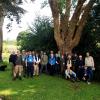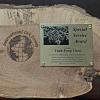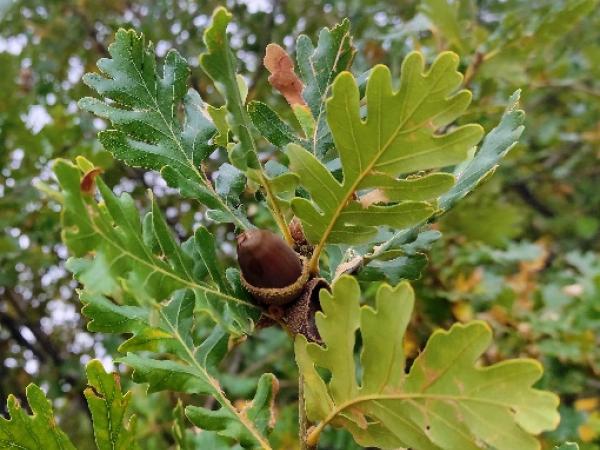Editor's Picks
Plant Focus
Although Turkey is one of the richest countries in the Western Palearctic in terms of plant diversity and endemism, tree endemics are surprisingly rare. Among this group, Quercus vulcanica stands out as a unique example: an endemic White Oak that combines ecological significance with cultural history. The species was first published by Theodor Kotschy in Die Eichen Europa’s und des Orients (Kotschy 1859), based on material associated with Boissier and Heldreich. Multiple floristic works, including Hedge & Yaltırık (1982), commonly cite the type locality (locus classicus) as Karaman–Karadağ, a volcanic massif in Central Anatolia at 1,750–2,000 m. The Latin epithet vulcanica explicitly refers to the volcanic mountains and bedrocks where this oak naturally thrives, while its Turkish name, Kasnak meşesi, comes from the traditional embroidery hoops (kasnak) once crafted from its durable wood. In many Anatolian villages, Q. vulcanica is valued not only as part of the forest but also as a source of these finely made tools, linking the species to both landscape and local culture.

Range and habitats
The core range of Q. vulcanica lies in the Lakes Region (Göller Yöresi) of southwestern Anatolia, particularly around Eğirdir (in Isparta), the Sultan Mountains (in Afyon), and Türkmen Mountain. From there, populations extend in scattered and often isolated groups toward Afyon and Kütahya, parts of Central Anatolia, the Amanos Mountains (Anti-Taurus), and even as far as the western Black Sea region. Several volcanic massifs—Karadağ, Karacadağ, Hasan Dağ, Melendiz, and Erciyes—also host notable stands, reflecting the species’ affinity with these rocky volcanic landscapes.


Most literature reports its elevational range between 1,300 and 2,000 m, often on north- or east-facing slopes with volcanic or limestone bedrock. Yet in my own field studies, I observed populations as low as 1,150 m in the Sultan Mountains (Afyon). Across its distribution range, Q. vulcanica can be observed as pure or forming mixed stands with conifers and other oak species, more specifically with Cedrus libani and Juniperus in the Isparta region, with Abies in Kastamonu region, and with Pinus nigra and P. sylvestris in other distribution regions, according to my observations. It also forms mixed stands with other oaks: most prominently Q. cerris, but also Q. infectoria, Q. trojana, Q. coccifera, Q. pubescens, Q. robur, Q. petraea and, in its northernmost populations, with Q. macranthera subsp. syspirensis. All these habitats are characterized by distinct climatic regimes, from cool-humid to semi-arid cold bioclimates. This shows the ecological versatility of Q. vulcanica and reflects the rich forest mosaics of Anatolia.

Leaves, acorns, and form
Quercus vulcanica oak is a large deciduous tree, often reaching up to 25–30 m in height, with a broad crown and a grey, deeply fissured bark on older trunks. Leaves are typically 9–17 cm long and 5–10 cm wide, deeply lobed, and ovate to elliptic in shape. The undersides have a soft layer of stellate hairs, while the upper surface is mostly smooth or only sparsely pubescent. Petioles are relatively long (0.8–3.5 cm), which, together with the velvety undersides, helps distinguish Q. vulcanica from its close relative Q. frainetto (Yaltırık 1984). In the Kasnak Oak Nature Reserve Area, I recorded individuals with the largest leaf areas among all populations I studied.


The acorns mature within a single year, usually measuring 27–38 mm long and 15–20 mm wide. Their cupules are about 11–17 mm deep and 15–20 mm across, covering half to two-thirds of the nut. Like many oaks, the species is reported in the literature to produce good seed years every three to four years. Yet in my observations, I noticed that, compared to its frequent companion Q. cerris, Q. vulcanica produces far fewer acorns even in good years. This scarcity of seed made me think about how it might stand at a disadvantage in competition with other oak species.

Quercus vulcanica is more than just an endemic tree: it is an important component of Anatolia’s mountain ecosystems. Old individuals help stabilize soils, regulate water, and provide habitat for many other species. Studies of hollow oaks in Turkey have even described new insects, such as the longhorn beetle Poecilium kasnaki, while other saproxylic beetles like Trichoferus pallidus or Protaetia aeruginosa are also associated with old-growth oak trees (Sama et al. 2011). These examples show us how a single veteran tree can harbor unique biodiversity, but, at the same time, they underline the importance of conserving entire populations and forest stands, many of which are distributed within the Key Biodiversity Areas of Turkey, overlapping with habitats of threatened birds, mammals, and plants.

Values and vulnerability
Today, however, the species faces multiple challenges that threaten its long-term survival. Some have been continuing for centuries due to human use; others are the product of present-day land use and climate change. Together, they help explain why the species often appears only in scattered groups with poor regeneration. For centuries it has been sought for its strong, fine-grained wood for timber exploitation, flooring, and furniture. Even today, despite legal protection, illegal cutting continues in some stands. In many localities, livestock grazing prevents seedlings from surviving. The species’ range also overlaps with some of Turkey’s most fire-prone regions, and with climate change increasing both the frequency and severity of fires, the risks to regeneration are rising. Added to this are the impacts of land-use changes, which steadily fragment and reduce the already scattered populations (Ülker 2023).




In the field
During my surveys of Q. vulcanica populations, I almost always encountered local forest villagers or forestry officers, and our conversations often revealed another dimension of the story. In one particularly memorable encounter near Lake Beyşehir, I was searching for Q. vulcanica individuals hidden among an old Cedrus forest when I met a retired forest worker. He recalled that, in earlier decades, destructive cuttings had been carried out in Q. vulcanica stands in the region under orders from the forestry administration, simply due to the need for timber and because the species was not yet recognized as endemic or particularly “ecologically” valuable. The trees were logged without distinction, and in the aftermath other species became dominant, while Q. vulcanica struggled to return. What he described was exactly what I had seen myself: old trees with almost no young saplings, showing how past use still shapes the present status of the species.
In the same forest, the retired forest worker led my father and me (yes, my father loves to join me on almost all of my field studies) to a tree he believed to be even larger than the officially recognized champion Q. vulcanica. After a long walk into the Cedrus libani woods, we finally stood before it: a massive trunk, hollowed with age, yet still alive and surrounded by many seedlings. Its size exceeded that of Q. vulcanica individual officially registered as the largest in Turkey, which is located in Kasnak Oak Nature Reserve Area. Standing beneath this giant, with its offspring clustered around its roots, was for me a moment of awe, one of those encounters that reminded me why fieldwork is never just data collection, but also discovery.

Another surprising tree that I came across was in the deepest part of Kasnak Oak Nature Reserve Area, one of the most remarkable trees I have ever seen. This giant Q. vulcanica, with five fused trunks rising together, forms a living monument. As I climbed among its pillar-like trunks, I felt like a part of its history.

Conservation status
Quercus vulcanica is listed as Least Concern (LC) on the IUCN Red List. Yet recent work in Turkey suggests a different picture. As part of the Turkey’s Plants National Red List project, led by Doğa Koruma Merkezi (Nature Conservation Centre), I carried out a new assessment of the species in 2025, following IUCN Red List standards. This evaluation was based on visits to all known populations, where I recorded approximate numbers of individuals, observed pressures such as grazing, illegal cutting, and fire risk, conducted interviews with the locals, and considered the species’ potential distribution under future climate scenarios. Taken together, these findings indicated a continuing decline and fragmentation across its range. The resulting recommendation was to uplist Q. vulcanica to Endangered (EN).
Protecting Q. vulcanica means more than safeguarding an endemic species: it is about preserving a living piece of Anatolia’s natural heritage, one that carries the memory of its landscapes, its people, and its forests into the future.
Acknowledgment
My sincere thanks to Roderick Cameron, for his valuable guidance, particularly in clarifying the historical details of Q. vulcanica's original publication. This process has also been a valuable learning experience for me.
Works cited
Hedge, I. C., & Yaltırık, F. 1982. Flora of Turkey and the East Aegean Islands (Vol. 7). Edinburgh University Press.
Kotschy, T. 1859. Die Eichen Europa’s und des Orients (Part 4: Pl. 16–20). Wien: Carl Gerold’s Sohn [link]
Sama, G, N. Jansson, M. Avci, O. Sarikaya, M. Coskun, T. Kayış, and H. Özdikmen. 2011. Preliminary report on a survey of the saproxylic beetle fauna living on old hollow oaks (Quercus spp.) and oak wood in Turkey (Coleoptera: Cerambycidae). Munis Entomology & Zoology 6(2). 819-831 [link]
Ülker, E.D. 2023. The comparison of climatic niches, plant functional traits and the late Quaternary refugia of oaks (Quercus) distributed in different biomes of the Western Palearctic region (Doctoral dissertation, Hacettepe University, Institute of Science). Hacettepe University Open Access [link]
Yaltırık, F. 1984. Türkiye Meşeleri Teşhis Kılavuzu. İstanbul Üniversitesi Orman Fakültesi Yayınları [in Turkish] [link]















